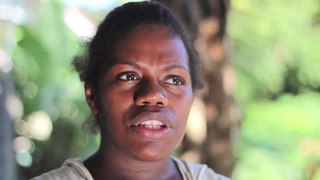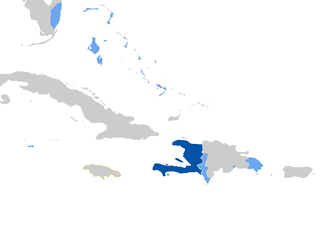| Merico | |
|---|---|
| Americo-Liberian, American, Brokes English, Kwasai English, Waterside English, Water Street English | |
| Region | Liberia |
| Ethnicity | Americo-Liberians |
English Creole
| |
| Language codes | |
| ISO 639-3 | – |
Merico or Americo-Liberian (or the informal colloquial name "American") is an English-based creole language spoken until recently in Liberia by Americo-Liberians, descendants of original settlers, freed slaves, and African Americans who emigrated from the United States between 1821 and the 1870s. It is distinguished from Liberian Kreyol and from Kru, and may be connected to Gullah and Jamaican Creole. [1]
The original settlers numbered 19,000 in 1860. [1] By 1975 the language was partly decreolized, restricted to informal settings. [1]
Plurals are unmarked, as in rak "rock", "rocks", or marked with a -dɛ̃ suffix, as in rak-dɛ̃ "rocks". The verb expressing "to be" is sʌ, as in shi sʌ smo "she is small", but adjectives may be used without it, as in hi big "he is big". Verbs are not inflected for past tense. [1]
Separate particles are used to indicate some verb tenses: [1]
The pronouns include: [1]
In linguistics, a copula is a word or phrase that links the subject of a sentence to a subject complement, such as the word is in the sentence "The sky is blue" or the phrase was not being in the sentence "It was not being co-operative." The word copula derives from the Latin noun for a "link" or "tie" that connects two different things.

Bislama is an English-based creole language and one of the official languages of Vanuatu. It is the first language of many of the "Urban ni-Vanuatu" and the second language of much of the rest of the country's residents. The lyrics of "Yumi, Yumi, Yumi", the country's national anthem, are composed in Bislama.
In grammar, a future tense is a verb form that generally marks the event described by the verb as not having happened yet, but expected to happen in the future. An example of a future tense form is the French aimera, meaning "will love", derived from the verb aimer ("love"). The "future" expressed by the future tense usually means the future relative to the moment of speaking, although in contexts where relative tense is used it may mean the future relative to some other point in time under consideration.
Liberian English refers to the varieties of English spoken in Liberia. There are four such varieties:
The past tense is a grammatical tense whose function is to place an action or situation in the past. Examples of verbs in the past tense include the English verbs sang, went and washed. Most languages have a past tense, with some having several types in order to indicate how far back the action took place. Some languages have a compound past tense which uses auxiliary verbs as well as an imperfect tense which expresses continuous or repetitive events or actions. Some languages inflect the verb, which changes the ending to indicate the past tense, while non-inflected languages may use other words meaning, for example, "yesterday" or "last week" to indicate that something took place in the past.

The going-to future is a grammatical construction used in English to refer to various types of future occurrences. It is made using appropriate forms of the expression to be going to. It is an alternative to other ways of referring to the future in English, such as the future construction formed with will – in some contexts the different constructions are interchangeable, while in others they carry somewhat different implications.

Haitian Creole, or simply Creole, is a French-based creole language spoken by 10 to 12 million people worldwide, and is one of the two official languages of Haiti, where it is the native language of the vast majority of the population. Northern, Central, and Southern dialects are the three main dialects of Haitian Creole. The Northern dialect is predominantly spoken in Cap-Haïtien, Central is spoken in Port-au-Prince, and Southern in the Cayes area.

Torres Strait Creole, also known as Torres Strait Pidgin, Brokan/Broken, Cape York Creole, Lockhart Creole, Kriol, Papuan, Broken English, Blaikman, Big Thap, Pizin, and Ailan Tok, is an English-based creole language spoken on several Torres Strait Islands of Queensland, Australia; Northern Cape York; and south-western coastal Papua New Guinea (PNG).

Chavacano or Chabacano is a group of Spanish-based creole language varieties spoken in the Philippines. The variety spoken in Zamboanga City, located in the southern Philippine island group of Mindanao, has the highest concentration of speakers. Other currently existing varieties are found in Cavite City and Ternate, located in the Cavite province on the island of Luzon. Chavacano is the only Spanish-based creole in Asia. The 2020 Census of Population and Housing counted 106,000 households generally speaking Chavacano.
A modal verb is a type of verb that contextually indicates a modality such as a likelihood, ability, permission, request, capacity, suggestion, order, obligation, necessity, possibility or advice. Modal verbs generally accompany the base (infinitive) form of another verb having semantic content. In English, the modal verbs commonly used are can, could, may, might, shall, should, will, would, ought to, used to and dare.

Jamaican Patois is an English-based creole language with West African, Taíno, Irish, Spanish, Hindustani, Portuguese, Chinese, and German influences, spoken primarily in Jamaica and among the Jamaican diaspora. Words or slang from Jamaican Patois can be heard in other Caribbean countries, the United Kingdom and Toronto, Canada. The majority of non-English words in Patois derive from the West African Akan language. It is spoken by the majority of Jamaicans as a native language.
Cape Verdean Creole is a Portuguese-based creole language spoken on the islands of Cape Verde. It is the native creole language of virtually all Cape Verdeans and is used as a second language by the Cape Verdean diaspora.

Cameroonian Pidgin English, or Cameroonian Creole, is a language variety of Cameroon. It is also known as Kamtok. It is primarily spoken in the North West and South West English speaking regions. Five varieties are currently recognised:
Limonese Creole is a dialect of Jamaican Patois, an English-based creole language, spoken in Limón Province on the Caribbean Sea coast of Costa Rica. The number of native speakers is unknown, but 1986 estimates suggests that there are fewer than 60,000 native and second language speakers combined.
The Japanese Sign Language syllabary is a system of manual kana used as part of Japanese Sign Language (JSL). It is a signary of 45 signs and 4 diacritics representing the phonetic syllables of the Japanese language. Signs are distinguished both in the direction they point, and in whether the palm faces the viewer or the signer. For example, the manual syllables na, ni, ha are all made with the first two fingers of the hand extended straight, but for na the fingers point down, for ni across the body, and for ha toward the viewer. The signs for te and ho are both an open flat hand, but in te the palm faces the viewer, and in ho it faces away.
Unserdeutsch, or Rabaul Creole German, is a German-based creole language that originated in Papua New Guinea as a lingua franca. The substrate language is assumed to be Tok Pisin, while the majority of the lexicon is from German.

Belizean Creole is an English-based creole language spoken by the Belizean Creole people. It is closely related to Miskito Coastal Creole, San Andrés-Providencia Creole, and Jamaican Patois.
Saint Lucian Creole is a French-based creole language that is widely spoken in Saint Lucia. It is the vernacular language of the country and is spoken alongside the official language of English.
Tense–aspect–mood or tense–modality–aspect is a group of grammatical categories that are important to understanding spoken or written content, and which are marked in different ways by different languages.
Port Jackson Pidgin English or New South Wales Pidgin English is an English-based pidgin that originated in the region of Sydney and Newcastle in New South Wales in the early days of colonisation. Stockmen carried it west and north as they expanded across Australia. It subsequently died out in most of the country, but was creolised in the Northern Territory at the Roper River Mission (Ngukurr), where missionaries provided a safe place for Indigenous Australians from the surrounding areas to escape deprivation at the hands of European settlers. As the Indigenous Australians who came to seek refuge at Roper River came from different language backgrounds, there grew a need for a shared communication system to develop, and it was this that created the conditions for Port Jackson Pidgin English to become fleshed out into a full language, Kriol, based on English language and the eight different Australian language groups spoken by those at the mission.